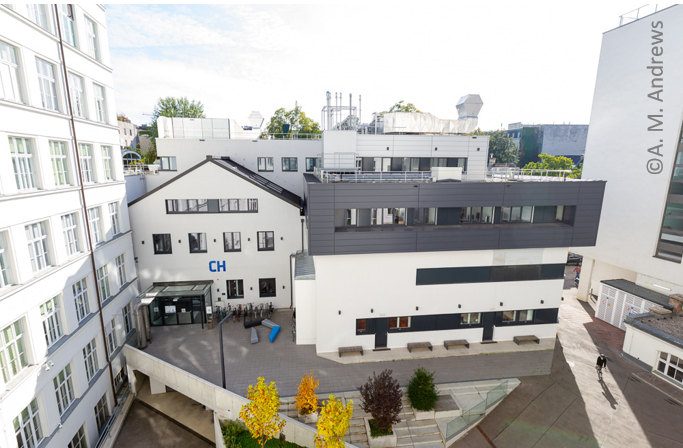Applications in Spectroscopy & Telecom
Research on Applications in Spectroscopy & Telecom
The mid-infrared spectral range covers a very broad range of applications. They are nowadays extensively using optoelectronic devices including QCLs, QCDs, ICLs and photonic integrated circuits (PICs) which are composed of the former mentioned “building blocks”. In particular, the mid-infrared field is often divided into multiple parts, out of which two of the most prominent and thus relevant are: 1. Mid-infrared Spectroscopy of Molecules and 2. Mid-infrared Optical Free-Space Communication in the Atmosphere.
- Mid-infrared Spectroscopy of Molecules
Mid-infrared spectroscopy covers the detection and analysis of molecules in gas [1-3], liquid [4-7] and solid phase [8], by addressing their fundamental roto-vibrational absorptions. This enables the realization of very sensitive and selective tools for monitoring molecules. While especially the field of mid-infrared gas-phase spectroscopy made tremendous improvements in recent years, yielding portable sensing devices with limit of detection on the parts-per-trillion (ppt) scale, liquid-phase spectroscopy is still in its infancy. It was so far mainly hampered by missing concepts to realize interaction distances with the liquid analyte beyond a few to some tens of micrometers (simplified device and liquid handling) together with compact and portable device schemes, avoiding bulky equipment. Moreover, bringing the latter capabilities to real-world devices potentially enables spectrometers for dynamic reaction monitoring of liquids, i.e. in situ experiments analyzing changes in the liquid in real time.
In the following we will show our current activities in the field of mid-infrared spectroscopy based on novel types of optoelectronic devices and PICs with a main focus on liquid phase spectroscopy and gas sensing. - Mid-infrared Optical Free-Space Communication in the Atmosphere
In contrast to spectroscopy, optical free-space communication in the mid-infrared relies on transparent spectral windows in the atmosphere, i.e. avoiding the absorption lines of gas molecules. In this context, water (vapor) is the main molecule that leads to strong absorptions in the atmosphere due to its high concentration and strong absorption lines.
Fortunately, there are multiple of those spectral windows of low attenuation, e.g. between wavelengths of 8 – 12 µm. This range is often referred to the long-wave infrared (LWIR). It is characterized by a low atmospheric attenuation [9], insensitivity to atmospheric turbulences [10] and superior optical transmission characteristics [11]. However, suitable chip-scale optoelectronic devices including emission source(s), detectors, amplifiers, modulators are still missing. One reason can be found in the decreasing performance of QC and IC devices. This happens when they are designed and operated further away from their “performance sweet-spots” (~3 – 5 µm), as for suitable devices used in free-space telecommunication at longer wavelength >8 µm.
In the section below, our efforts and advancements in the field of realizing compact devices for mid-infrared free-space communication will be presented.
Gas Spectroscopy based on Surface-emitting QCLs [12] and ICLs [13]
The spectroscopy of molecules in the gas phase needs to account for measuring in a medium that is very dilute and therefore has macroscopic absorption lengths (the distance into the probed sample, for which the intensity drops to 1/e of its initial value). Thus, for realizing highly sensitive spectrometers with detection limits into the parts-per-billion (ppb) or even ppt range, typically two options exist. Either long interaction lengths with the sample on the meter scale in multi-reflection gas cells are used [14] or special measurement techniques like e.g. balanced-detection interferometric cavity-assisted photothermal spectroscopy (BICAPS) [15], quartz-enhanced photoacoustic spectroscopy (QEPAS) [16] or heterodyne phase-sensitive dispersion spectroscopy (HPSDS) [17] are used. It is often beneficial to combine both approaches, i.e. long interaction length and special measurement techniques, into one high-performance spectrometer.
In the following, the measurement of 0.4% of CH4 in N2 at 24 mbar in a 10-cm-long gas cell is demonstrated [12]. This work was an highly collaborative effort, combining the expertise of different groups on mid-infrared optoelectronics and analytical chemistry. A surface emitting ring-QCL with second-order distributed feedback (DFB) grating for vertical light extraction and single-mode emission was used as excitation source. Its emission at 1322.08 cm-1 guided through the gas cell and subsequently measured on a mercury-cadmium-telluride (MCT) detector. The detailed results are given in the following:
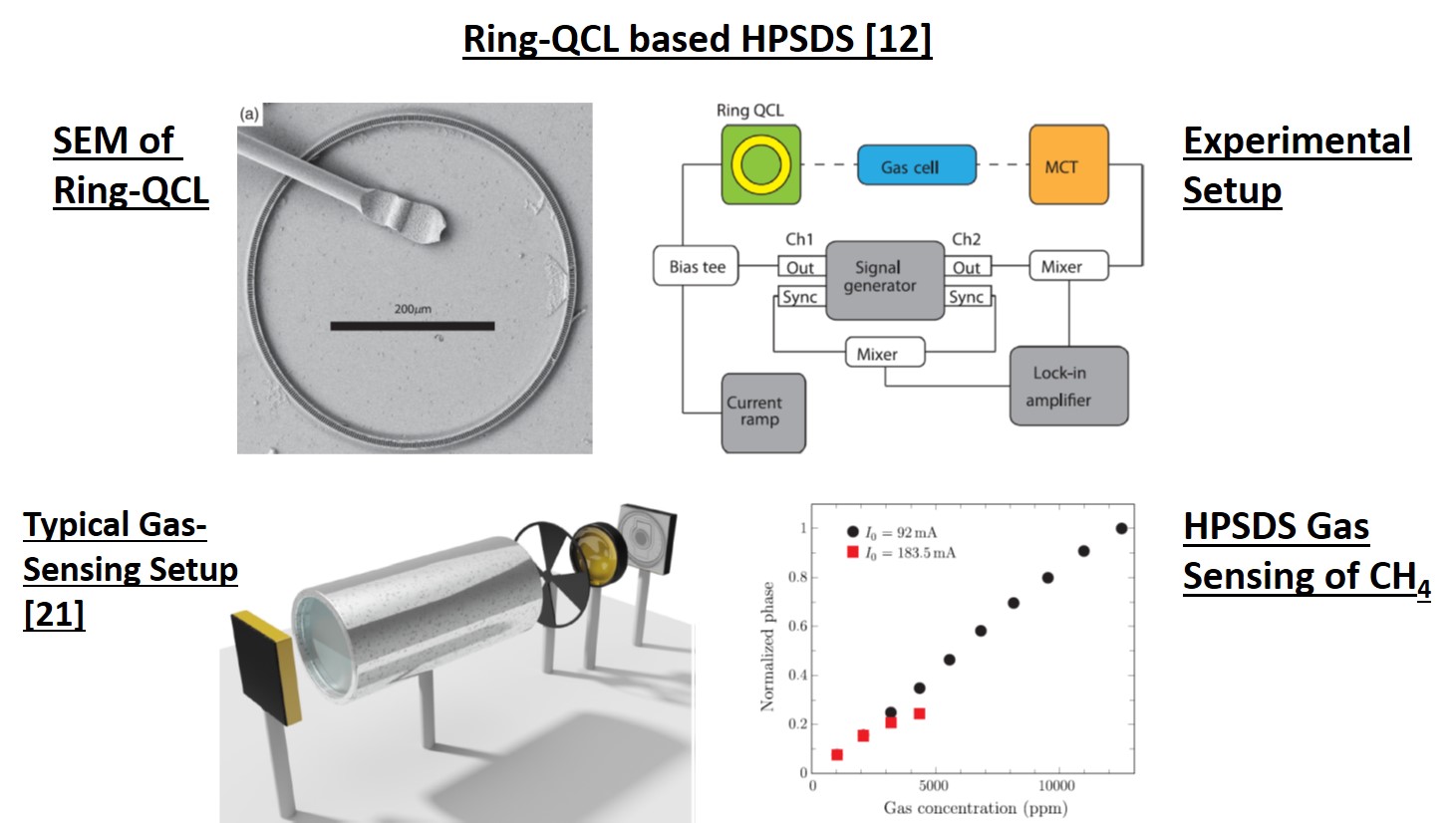
As an alternative, also similar substrate-emitting 2nd-order DFB ring-ICLs [13] can be used for spectroscopic measurements based on BICAPS [15]. In contrast to other techniques, BICAPS strongly benefits from miniaturization and therefore is a very appealing technique for compact measurement setups. In the following the ring-ICL (the same as under “Active Optoelectronic Devices, section c.) and first modulation spectroscopy measurements, as pre-requisite for the BICAPS are shown:
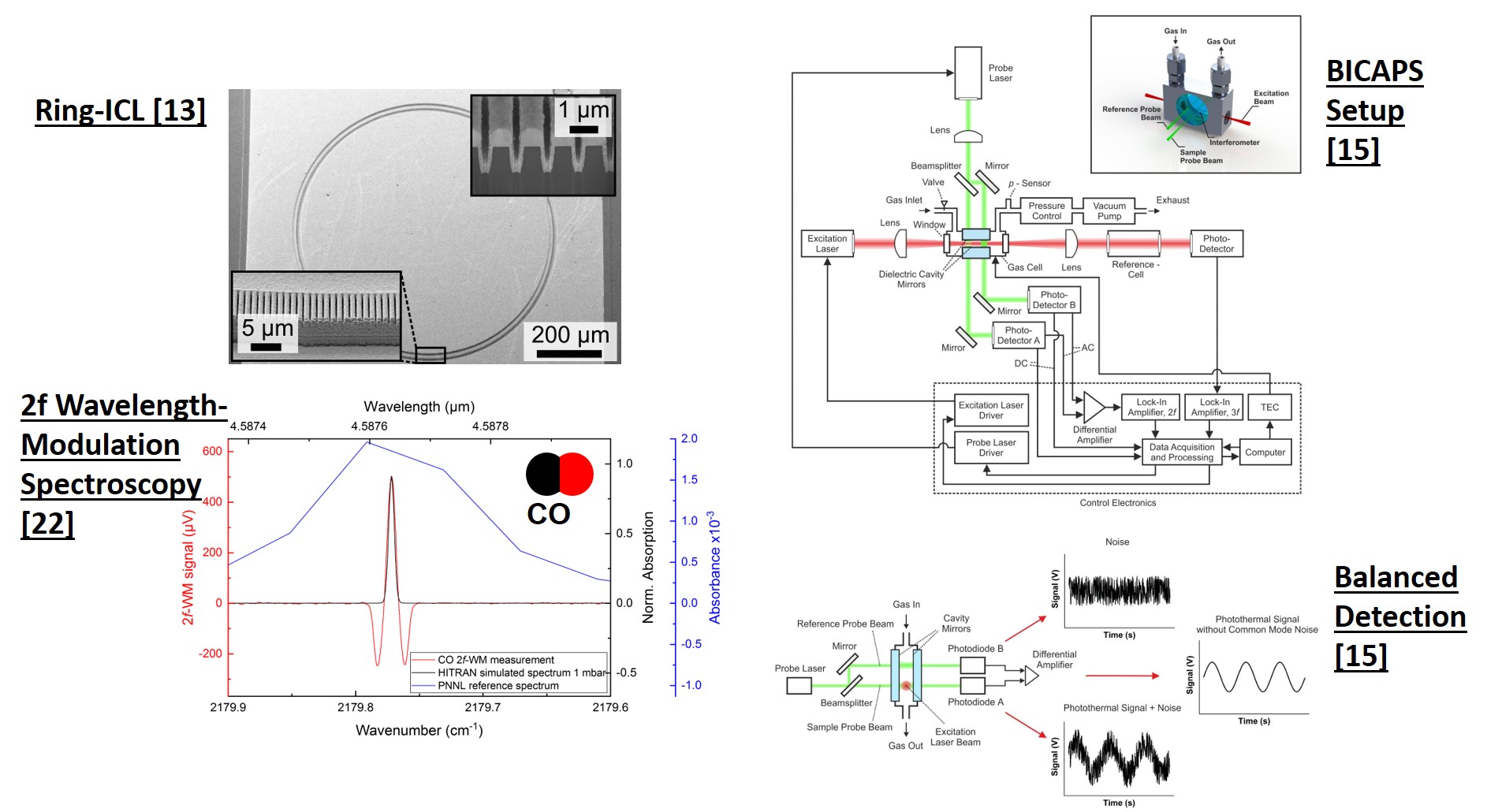
PIC-based Liquid Spectroscopy in Real-Time [7]
While gas-phase spectroscopy typically relies on techniques to increase the effective interaction length with the medium, measuring molecules in liquid-phase has to deal with the opposite situation: a high-density medium, which is often difficult to be penetrated by mid-infrared radiation due to its strong absorbance. Thus, so far devices with interaction-lengths on the micrometer scale have been used for this. While when using mid-IR laser-sources (QCLs, ICLs) the penetrated length into the liquid can be increased by about one order of magnitude to ~10s of micrometers as compared to using broadband Fourier-transform IR-spectrometers (FTIRs), existing setups are still rather bulky. This results in time consuming offline analytics, moreover often limited to a laboratory environment.
Here we present the use of a novel type of PIC device, that combines QCL and QCD with a surface sensitive plasmonic waveguide in a linear geometry (for details also see “Photonics Integrated Circuits”, section a. on this website) [6,7]. We used it in in situ experiments for reaction monitoring liquids in real time. For this the sensor can be directly submerged into the liquid sample without additional coating, enabling monitoring changes while they occur. We demonstrate the capabilities for highly-sensitive (limit of detection: 75 ppm) measurement by analyzing the thermal denaturation process of the protein bovine serum albumin (BSA) with our fingertip-sized lab-on-a-chip sensor at 1620 cm-1:
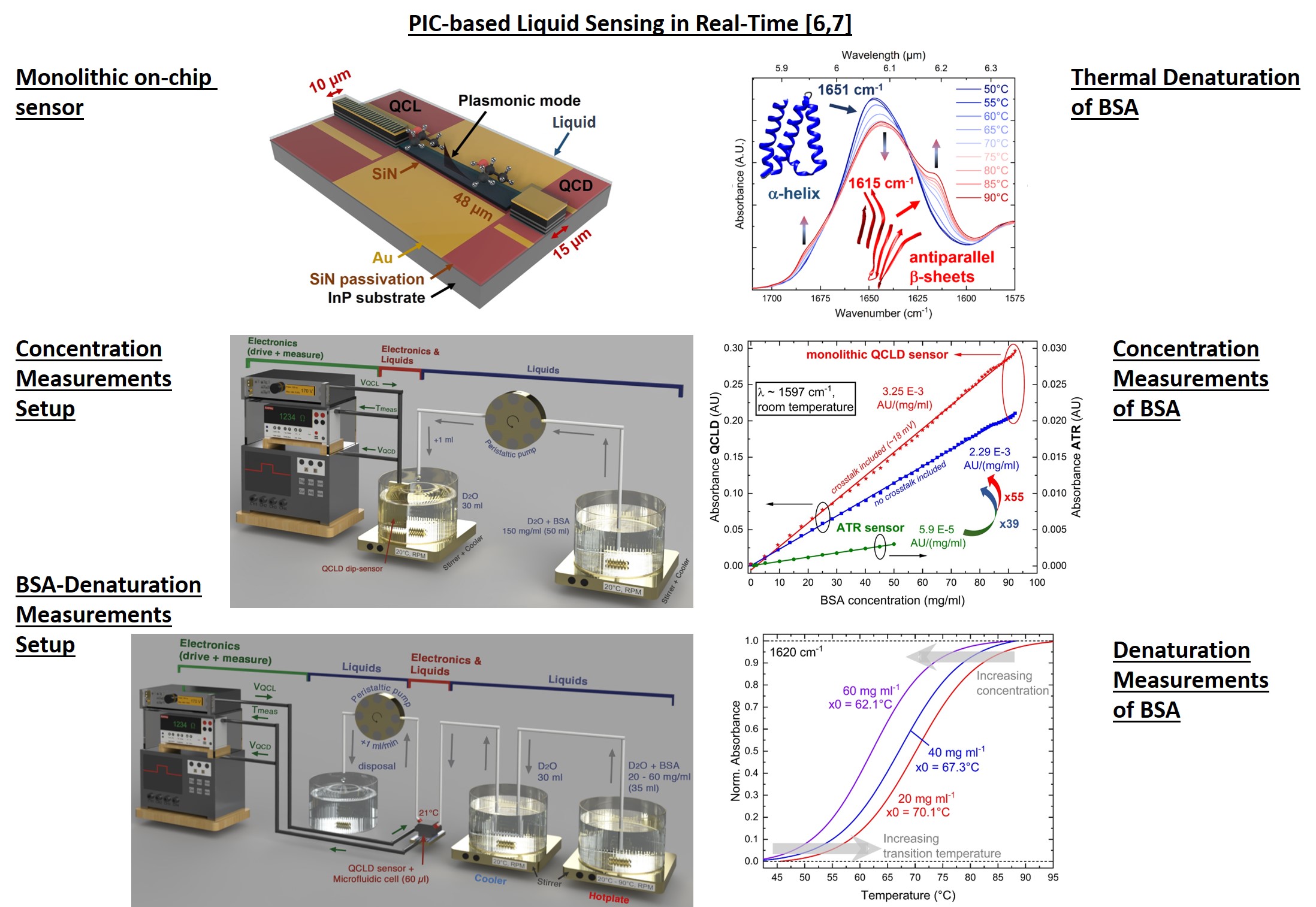
Towards Optical Free-Space Telecommunication in the mid-IR Spectral Range [18-20]
As previously discussed, optical free-space telecommunication in the LWIR shows various beneficial features including low atmospheric attenuation by water vapor, insensitivity to atmospheric turbulences and better beam collimating capabilities [9-11]. To demonstrate and exploit the potential for real-world data-transmission experiments, we are currently developing a LWIR heterodyne receiver. It is the chip-scale version [18] of its discrete-components-counterpart and is in its simplest form composed by a local oscillator, LO (e.g. a DFB-QCL) together with a neighboring waveguide (or more advanced: semiconductor optical amplifier, SOA) for coupling the external radiation that carries the transmission signal information. The radiation of both sources is combined and mixed by a plasmonic y-coupler [19,20] and detected by the on-chip QCD.
Fundamentally, it works the way that the external carrier signal that travels through the atmosphere and therefore can be very weak, is mixed with the high power of the LO and the resulting beating signal is measured with the on-chip QCD. A sketch of this approach is shown in the following:
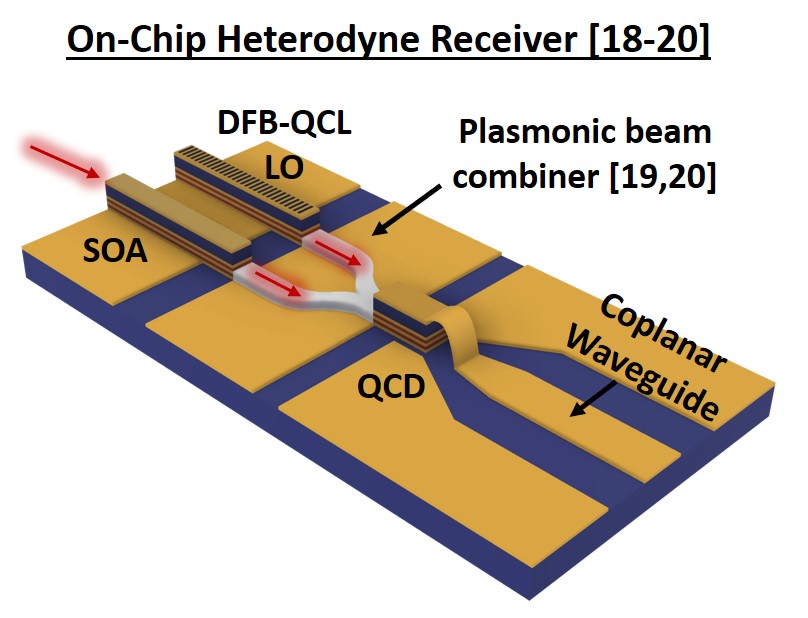
[1] G. Wysocki and D. Weidmann, Opt. Express 18, 26123 (2010).
[2] V. Spagnolo, P. Patimisco, S. Borri, G. Scamarcio, B. E. Bernacki, and J. Kriesel, Opt. Lett. 37, 4461 (2012).
[3] R. Szedlak, J. Hayden, P. Martín-Mateos, M. Holzbauer, A. Harrer, B. Schwarz, B. Hinkov, D. MacFarland, T. Zederbauer, H. Detz, A. M. Andrews, W. Schrenk, P. Acedo, B. Lendl, and G. Strasser, Opt. Engineering 1, 011005 (2018).
[4] M. R. Alcaráz, A. Schwaighofer, H. Goicoechea, and B. Lendl, Spectrochim. Acta – Part A Mol. Biomol. Spectrosc. 185, 304–309 (2017).
[5] O. Bibikova, J. Haas, Á. I. López-Lorente, A. Popov, M. Kinnunen, Y. Ryabchikov, A. Kabashin, I. Meglinski, and B. Mizaikoff, Anal. Chim. Acta 990, 141–149 (2017).
{6] B. Schwarz, P. Reininger, D. Ristanic, H. Detz, A. M. Andrews, W. Schrenk, and G. Strasser, Nat. Commun. 5, 4085 (2014).
[7] B. Hinkov, F. Pilat, L. Lux, P. L. Souza, M. David, A. Schwaighofer, D. Ristani, B. Schwarz, H. Detz, A. M. Andrews, B. Lendl, and G. Strasser, Nat. Commun. 13, 4753 (2022).
[8] F. Fuchs, B. Hinkov, S. Hugger, J. M. Kaster, R. Aidam, W. Bronner, K . Köhler, Q. Yang, S. Rademacher, K . Degreif, F. Schnürer, and W. Schweikert, Proc. SPIE 7608 (2010).
[10] P. Corrigan, R. Martini, E. A. Whittaker, and C. Bethea, Opt. Express 17(6), 4355 (2009).
[11] J. J. Liu, B. L. Stann, K. K. Klett, P. S. Cho, and P. M. Pellegrino, Proc. SPIE 11133, (2019).
[12] R. Szedlak, J. Hayden, P. Martín-Mateos, M. Holzbauer, A. Harrer, B. Schwarz, B. Hinkov, D. MacFarland, T. Zederbauer, H. Detz, A. M. Andrews, W. Schrenk, P. Acedo, B. Lendl, and G. Strasser, Opt. Engineering 1, 011005 (2018).
[13] H. Knötig, B. Hinkov, R. Weih, S. Höfling, J. Koeth, and G. Strasser, Appl. Phys. Lett. 116, 131101 (2020).
[14] B. Tuzson, M. Mangold, H. Looser, A. Manninen, and L. Emmenegger, Opt. Lett. 38(3), (2013).
[15] J. P. Waclawek, C. Kristament, H. Moser, and B. Lendl, Opt. Express 27(9), 12183 (2019).
[16] Y. Ma, R. Lewicki, M. Razeghi, and F. K. Tittel, Opt. Express 21(1), 1008 (2013).
[17] P. Martín-Mateos, J. Hayden, P. Acedo, and B. Lendl, Anal. Chem. 89(11), 5916 (2017).
[18] M. David, G. Marschick, E. Arigliani, N. Opacak, B. Schwarz, G. Strasser, and B. Hinkov, 48th European Conference on Optical Communication (ECOC), Basel, Switzerland, 18 – 22 Sept, 202
[19] M. David, D. Disnan, A. Lardschneider, D. Wacht, H. T. Hoang, H. Detz, B. Lendl, U. Schmid, G. Strasser, and B. Hinkov, Opt. Mater. Express 12(6), 2168 (2022).
[20] M. David, A. Lardschneider, D. Disnan, H. T. Hoang, H. Detz, U. Schmid, G. Strasser, and B. Hinkov, in preparation.

